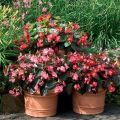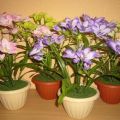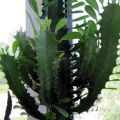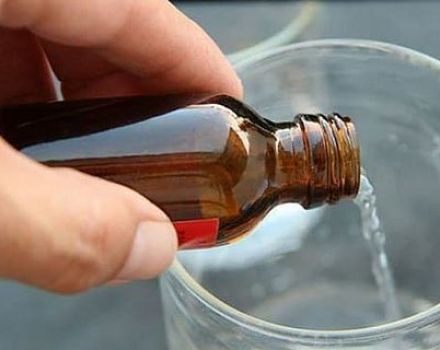Description of the euphorbia flower, planting and care at home
Many people have white-veined euphorbia because it has a beautiful appearance that resembles a miniature palm tree. It is believed that the plant protects against evil forces and neutralizes harmful radiation emanating from the computer. Even at the court of the Moorish king, the healing properties of the flower were used. Knowing about the healing capabilities of the plant, many grow it at home so that at any time there is an opportunity to prepare a medicine.
Variety selection
Thanks to the vigorous activity of breeders, more than 2000 plant species have been bred. Among them, 120 varieties are grown in Russia. The culture of the Euphorbia family is used in home and office floriculture. All euphorbia differ in the shape of leaves, inflorescences, but all have a milky poisonous juice.
The most common types include the following varieties:
- triangular - with a fleshy triangular stem;
- cypress - with needle-like leaves that change color during the growing season;
- white-veined - white veins are located on the leaves, from which the name originated;
- armored - narrow leaves are on an octahedral stem;
- obese - the look resembles a greenish ball and has no leaves;
- crown of thorns - has many thorns, but blooms very beautifully;
- poinsettia - pleases with scarlet flowers in December;
- the head of a jellyfish - with shoots resembling tentacles;
- palasa - has healing properties.
All varieties are quite unpretentious in care and are adapted for cultivation in Central Russia.

Features and description of milkweed
An ornamental deciduous plant belongs to the Succulentus group. With proper care, the plant reaches two meters in height. His homeland is Madagascar, so his native soil is sandy soil.
Stem and leaves
The stem of the flower is dark green and has a pentahedral shape. At the bottom it is thin, dense, and towards the top it gradually thickens and ribs. At the end of such faces, hard red bristles are formed. The fleshy shape of the trunk gradually grows stiff. And the lower part is smoothed and rounded over time.
There are no branches on the stem. Large bright green leaves with veins compensate for the deprivation of branches. They are juicy and fragile. If the petioles are damaged, the leaves fall off, and scars form in their place.

Young leaves rush upward, which gives them a similarity to a palm tree.The upper glossy part is darker than the lower one.
The properties of the plant include the fact that in the autumn it turns yellow and sheds its leaves. The process is explained by a short daylight hours. At the first warm sunbeams, the flower turns green again and grows overgrown with beautiful leaves.
Flowering and fruits
The plant has dull flowers that look out of the scales. They resemble white or white-brown thin sticky threads. Inflorescences are located in the axils of the upper leaves. The culture usually begins to bloom in the second year of life.
The fruits are collected in a three-nested box where the seeds are stored. At the moment of ripening, she shoots them. Once in a nearby pot, the seeds take root easily.

Susceptibility to disease and insects
Improper care can cause yellowing and shedding of leaves or black-brown spots on the leaves. Cold snap, lack of lighting, overflow can lead to fungal rot.
The most common plant diseases include:
- powdery mildew;
- black rot;
- viral infection tobacco mosaic;
- fusarium root rot.
If the home flower is affected by insects, then the leaves on the seamy side are strewn with multi-colored spots. Pests, parasitizing the plant, are very harmful to it. These parasites include:
- aphid;
- aleurodides;
- mealybug;
- spider mite.
Violation of crop care leads to the development of diseases and the attack of insects. First of all, weak plants are affected. If all the rules of agricultural technology are observed, the risk of infection is excluded.

Necessary conditions for growing
Despite the fact that the flower is not whimsical at home, it needs to provide optimal conditions for comfortable well-being.
Pot requirements
The dishes in which it will be convenient for the flower to grow should be wide enough. In this case, the depth should not be large, otherwise moisture will collect. And the plant does not like waterlogging.
If there are no holes in the bottom, you should make them yourself. Do not forget about drainage.
Euphorbia is not picky about the pot material. It can be made of ceramic, clay, wood or plastic.
Perfect soil
It is better to take soil for plants intended for cacti and succulents. They can be purchased at the store, or you can assemble them yourself. This requires the following components:
- peat mixture;
- river sand;
- deciduous humus;
- pebbles or expanded clay.
The composition is collected in the same proportion. Then a large drainage and the prepared mixture are placed on the bottom.
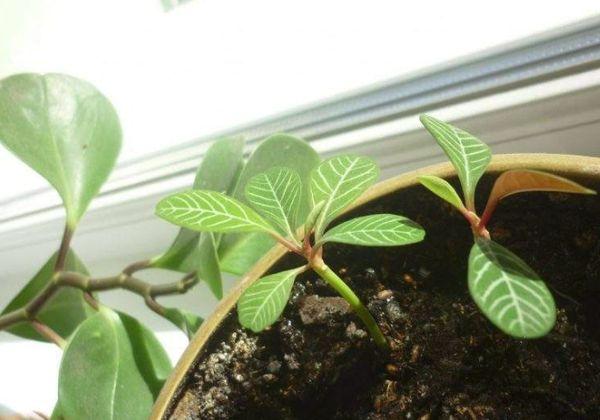
Air humidity
The room in which the flower grows needs systematic ventilation and relative humidity. It is preferable for the plant to be in a dry atmosphere, but away from heating appliances.
It is not recommended to spray the plant; it is better to wipe the leaves with a damp brush.
Optimal lighting
Culture needs diffused sunlight. If the flower is in constant shade, it loses the bright color of the leaves.
Important: after placing the flower on the windowsill, periodically turn it towards the light source.
Temperature regime
The flower is quite thermophilic. If the room temperature drops below 16 degrees, then the plant needs additional heating. In a cool room, euphorbia begins to hurt, harmful insects can infect.
Plant propagation methods
Any method is suitable for plant propagation. The event is recommended in spring.
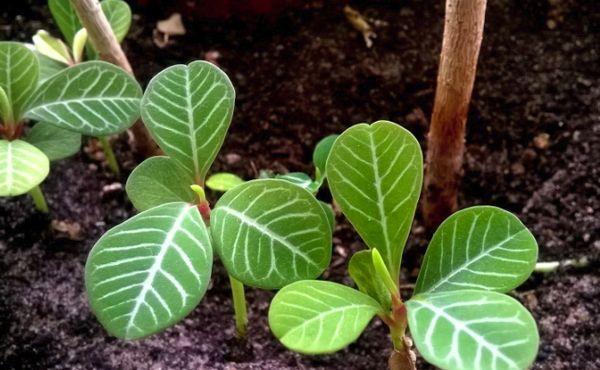
Seeds
Sowing is carried out in light soil and shallow. The soil is pre-moistened, the seeds are placed and covered with plastic wrap. The room should be warm and light. The seeds sprout quickly enough, so care must be taken to remove the polyethylene in time. As soon as several leaves appear, the shoots are transplanted into separate containers.
Cuttings
This method is recommended at the beginning of summer, since during this period shoots grow in the flower. With a sharp knife, the lateral processes are carefully cut off and placed in the water. The procedure is carried out in order to stop the secretion of juice. The stalk must be at least 10 centimeters long.
Cut shoots, if desired, are treated with root roots and stuck into the previously prepared soil. After that, you need to water well and put in a warm place. If everything is done correctly, the shoots will be taken within a week.
Planting and care at home
Planting, pruning, watering and transplanting into a larger container is included in plant care. When caring for a plant, remember that it grows in the wild in dry and warm climates. Therefore, it is desirable to maintain such an environment at home.
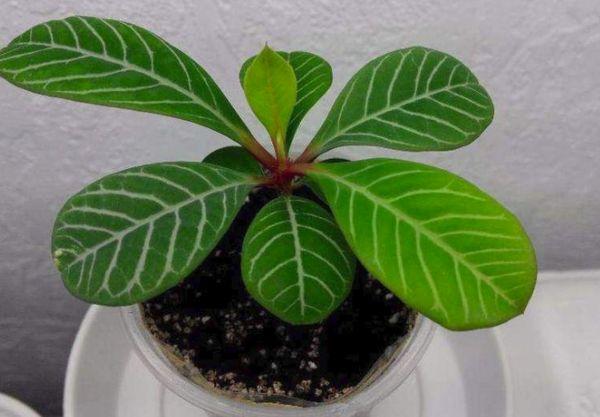
Buying and transplanting a plant
When purchasing a culture, it is necessary to check the absence of spots on the leaves, and whether the turgor of the shoots is normal. The flower should not have drooping leaves and shriveled trunk. A plant purchased in a special container requires transplanting.
You also need to transplant if such cases are noticeable:
- there is little space in the container for the roots;
- the plant began to rot;
- the root is affected by a fungal infection.
Repotting should be done regularly in order to change the dishes to a larger size and in order to change the soil to fresh. Over time, the soil is depleted.
Watering and fertilizing
The plant is comfortable with moderate watering. It starts to hurt as soon as there is stagnation of water. It grows poorly if you do not water the flower at all.
Important: it is better not to moisten the plant than to pour.
In summer, it is enough to water the flower 2-3 times a week, and in winter - once is enough. With the arrival of spring, the crop requires fertilization. For these purposes, they take top dressing that is suitable for all succulents. Fertilize once every 30 days.
Pruning
Pruning is done in order to rid the flower of dry shoots. Also, the procedure will give the culture a compact and beautiful shape.

Depending on how you prune your plant, you can achieve different results. Cutting off the top can trigger branching. To do this, cut off about 7 centimeters of the top with a sharp knife and sprinkle it with fly ash.
Cut off shoots or tops can be further used for propagation.
The main problems associated with growing
The culture grows well at home. Errors in grooming negatively affect flower growth. To avoid problems in growing, you need to revise the rules of maintenance.
The main complications include:
- leaf discharge - excess moisture;
- drying out of leaves - lack of nutrients;
- growths on the shoots - prolonged exposure to the sun.
To prevent the flower from contracting diseases and pests, it can be treated with insecticides.
The culture is easily adaptable to home conditions. With proper care, the result on the home windowsill will delight all year round. Do not discount the fact that the plant does not emit too much, but still toxic juice. Therefore, it is recommended to care for the crop with gloves.




